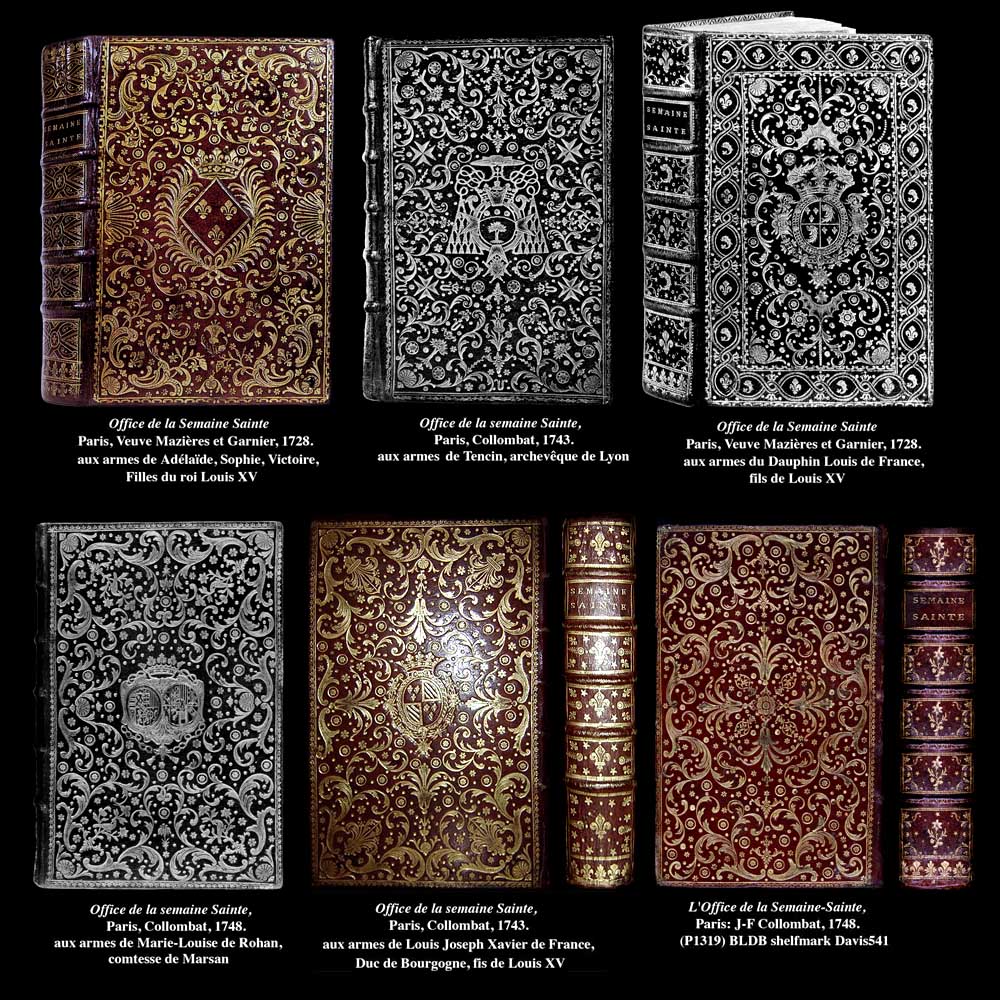

|
Pierre-Paul Dubuisson, one of the most famous bookbinders of his time, succeeded, in 1758, Antoine-Michel Padeloup as the royal bookbinder of Louis XV. In the diagram above I have assembled six extraordinary Dubuisson bindings (click on the diagram to see an enlargement). It is a strange fact that none of these binding have yet been attributed to Dubuisson, However we have now been able to show, that they are in fact the work of Dubuisson, One of todays greatest experts thinks that one of these bindings was executed by Derome or perhaps Derome's father? Another expert claims that they are by Padeloup! What do we really know about these bindings? Firstly we notice that 3 of them bear the arms of the sons and daughters of Louis XV, a fourth is that of their royal Governess. While another bears the arms of the archbishop of Lyon, Pierre Guérin de Tencin, the King's Minister of State. One would guess that such prestigious heirlooms would have been the charge of the kings own binder. Antoine-Michel Padeloup died on Thursday the seventh of September 1758, at the age of 73. By then, he had been the Kings binder for over 25 years, and had been making decorated bindings 20 or more years previous to that. It would be no surprise therefore if he had turned the over the painstaking and minitious work of gold tooling to a steadier hand, quite a few years before his death. We know that he had employed Dubuisons as binders and guilders for many years, because he owed them a considerable some of money at the time of his death. In fact he had been sued by Rene Dubuisson, perhaps as early as 1750 for money owing for their bookbinding services, and the money was still owing when he died. Thus it is possible and more than likely that Pierre-Paul Dubuisson had already been executing royal bindings well before 1758. There are a number of clues that may help us pinpoint when these particular bindings were made. Normally one would look to the publication date as a good indication of likely time when the bindings were executed. However with many of these Semaine Sainte editions showing up in decorated bindings many years later than the date they were published, the matter is far from clear. One of the best documented of the collection is that bearing the arms of Louis Joseph Xavier de France. Below is Norbert Donhofer's description of this amazing treasure; |

|
Olivier 2547; Wassermann (Brüssel, 1921), No. 1146; Cortlandt-Bishop Library V,225. Outstanding French 18th century binding. Contemporary red morocco, the sides entirely covered with a rich gilt tooled design of leaves, arabesques, stars, shells and pointillé, fleur-de-lys in the corners, panelled gilt back, with fleur-de-lys decoration, gilt edges, coat-of-armes of Louis Joseph Xavier de France, Duc de Bourgogne, brother of Louis XVI. He lived only from 1751 to 1761, hence bindings with his arms are extremely uncommon. From the libraries of E.von Wassermann (1921, item 1146), and Cordlandt Bishop (V,225). Olivier lists only five bindings with his arms ("Les volumes à ses armes sont des plus rares, ce prince étant mort á l'âge de 10 ans"). In a finely manufactured preservation box with title on spine. Rare! For more information about this binding contact Antiquariat Donhofer |
| Thus we have a window of 1751 to 1761, I thought that if we could trace down the other bindings with these same arms we might get a better idea of exactly when they might have been made, and I actually found one searching the internet, it came up for auction in a Paris auction in June of 2004. The item is described as bearing the armes of LOUIS-JOSEPH-XAVIER DE FRANCE, DUC DE BOURGOGNE, and the binding is described (below) as being decorated with a large dentelle rocaille. The term rocaille has become almost synonymous with decorative plaques of Dubuisson, and I'll wager that this is yet another Dubuisson binding, while the 1758 date of this publication strikes me as also being very significant. It may also follow that the LOUIS-JOSEPH-XAVIER binding shown above was also bound around this time, i. e., many years after the 1743 publication date. |
|
8 - ARCQ (Philippe-Auguste de Sainte-Foix, Chevalier d'). Histoire générale des guerres. Paris, de l'Imprimerie royale, 1756-1758. 2 volumes in-4, maroquin rouge, large dentelle rocaille, armoiries, dos richement orné, tranches dorées (Reliure de l'époque). EDITION ORIGINALE DE CET OUVRAGE CAPITAL POUR L'ETUDE DE L'HISTOIRE ARMENIENNE. Vaste projet historique divisé en trois époques, qui devait commencer avec le déluge et se terminer en 1748, mais dont seuls deux tomes furent publiés. Le premier contient une précieuse Histoire de la grande Arménie, celle des deux petites Arménies, & celle de la Cappadoce, le second, l'Histoire du reste des peuples de la basse Asie. Frontispice gravé par Chenu d'après Eisen, et un tableau dépliant. Fils naturel du comte de Toulouse, le chevalier d'Arcq, mort en 1779, a laissé plusieurs ouvrages historiques. PRECIEUX EXEMPLAIRE EN MAROQUIN A DENTELLE AUX ARMES DE LOUIS-JOSEPH-XAVIER DE FRANCE, DUC DE BOURGOGNE, fils de Louis de France et de Marie-Josèphe de Saxe, petit-fils de Louis XV, né à Versailles en 1751, et mort dans la même ville en 1761, avant sa dixième année. PROVENANCE DE TOUTE RARETE. Rousseurs. Frottements aux coins. est : 7.500 e Résultat : 8 000 |
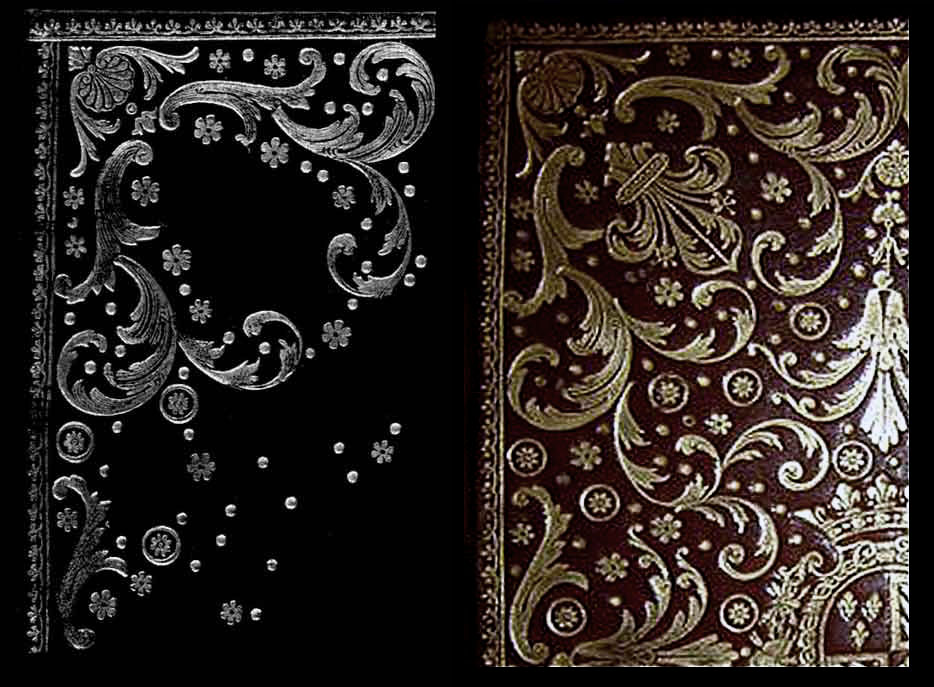
| In the diagram shown above I have removed some of the decorative imprints of part of the binding shown next to Louis-Joseph-Xavier's binding, we see that the remaining imprints are arranged in an identical way. The two bindings are so similar that one can easily imagine that they were made together. Below I show a similar comparison with a detail from the British Library example Davis 541, here again we see a similar arrangement and many of the same tools. I t may be that these bindings are all from the same period in the late 1750s, i.e., near to the end of Dubuisson's career and probably executed while he was employed as he kings official binder. |
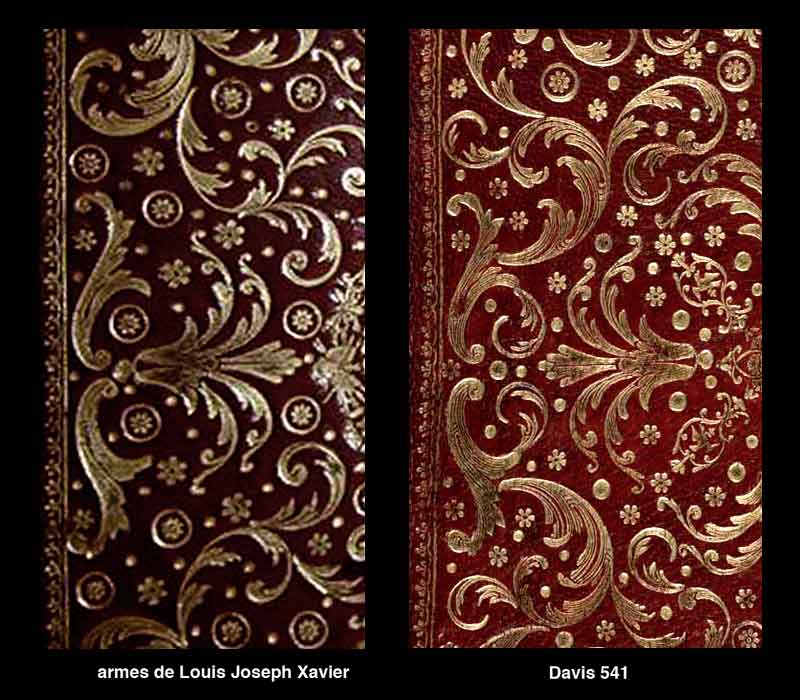
| Below I have reproduced a copy of the description of the Davis 541 binding (lot # 518), from a Sotheby's 1965 auction catalogue. Here is the beginning of a huge mess. The "expert" here has assumed that the French bookbinding expert Louis-Marie Michon was correct in attributing this particular decorative style, and tools to Padeloup,. He then goes on to state that the "tool of a bird" was "used later by Derome le jeune ". By this we are to assume that Padeloup's tool passed into the hands of Derome. However we can state categorically that Padeloup never used this bird tool, fer à l'oiseau. In no example of bindings where we find authentic Padeloup tools, do you see this tool, even though there are hundreds of proven Padeloup bindings. While on the other-hand this exact tool is present in many Dubuisson bindings. As for the case of Derome le jeune, he never used this exact tool, he used a reversed copy of it some years later (see Comparative Diagram 4). |
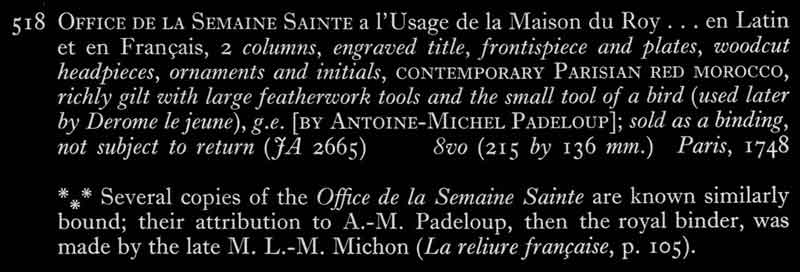
| Unfortunately this erroneous description has now been passed on for decades, even today certain highly respected experts unknowingly repeat Louis-Marie Michon's greatest blunder, to have never even recognized the work of one of the greatest artists of the century, and worse still, in attributng that work to the wrong person. Will poor Dubuisson ever be at rest in his grave? |
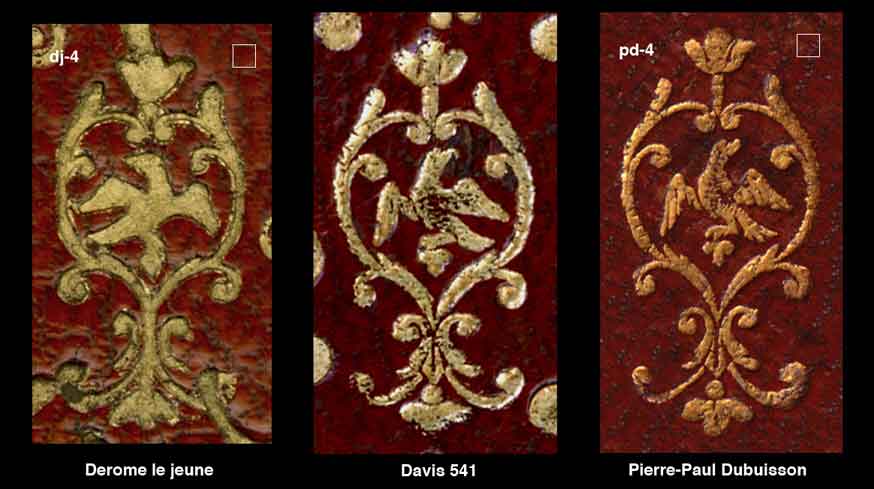
| information about the author | return to the home page of VIRTUAL BOOKBINDING |